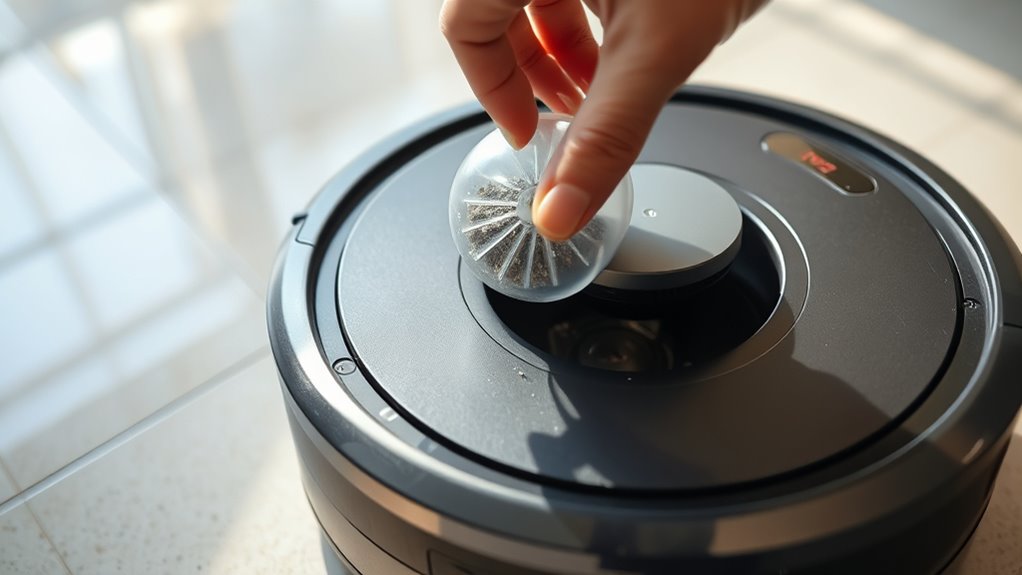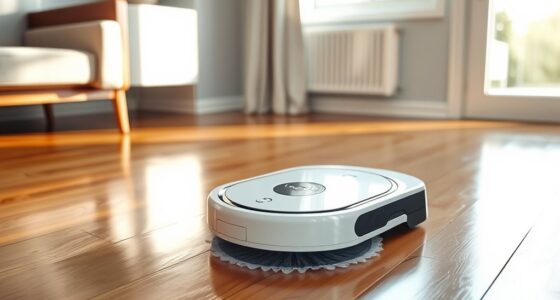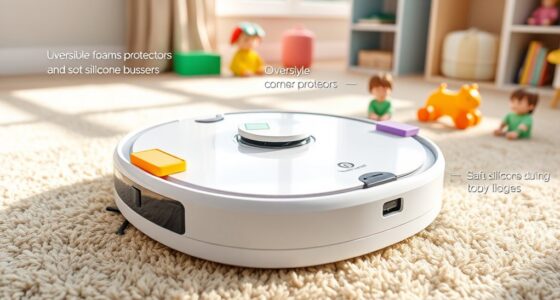To maintain your robot vacuum, regularly check and replace filters to keep airflow strong, and clean the brushes to prevent hair and debris from clogging them. Detach and inspect the brushes every few weeks, removing tangled hair with scissors or tools. Keep filters clean or swap them when dirty. Routine upkeep prevents motor strain, extends lifespan, and keeps cleaning performance ideal. To discover simple tips for smooth operation, continue exploring how to care for your smart cleaner.
Key Takeaways
- Regularly check and replace filters to maintain airflow and suction efficiency.
- Clean brushes and remove tangled hair or fibers to ensure proper spinning and floor contact.
- Schedule routine maintenance every few weeks, especially in high-traffic or pet areas.
- Use automation features to monitor and remind you of maintenance tasks remotely.
- Address issues promptly to prevent motor strain, battery drain, and costly repairs.

Keeping your robot vacuum clean is crucial for maintaining its performance and extending its lifespan. Regular maintenance guarantees it continues to clean effectively and prevents costly repairs down the line. The first step involves paying close attention to filter maintenance. Your vacuum’s filter traps dust, dirt, and allergens, but over time, it becomes clogged and less efficient. To keep it working at its best, check the filter regularly—usually once a month—and replace it when it looks dirty or after a few months of use, depending on your model’s recommendations. A clean filter allows for better airflow, which in turn improves suction power and cleaning efficiency. Ignoring filter maintenance can cause the vacuum to work harder, strain the motor, and ultimately shorten its lifespan.
Alongside filter maintenance, brush cleaning plays a essential role in keeping your robot vacuum operating smoothly. The brushes are responsible for loosening dirt and debris from floors, especially in corners and along edges. Hair, string, and fibers tend to get wrapped around the brushes, reducing their ability to spin freely and pick up debris effectively. To prevent this, regularly remove any tangled hair or fibers by detaching the brushes according to your vacuum’s instructions. Use scissors or a brush cleaning tool if needed, and make sure to clear out any debris lodged in the brush bearings or wheels. This simple step ensures that the brushes spin freely and maintain ideal contact with your flooring, whether you have carpets or hard surfaces.
Additionally, automation in business technologies are making it easier to schedule regular cleaning routines and monitor your vacuum’s performance remotely, enhancing your maintenance practices. Cleaning the brushes and maintaining the filter are quick tasks that greatly impact your vacuum’s performance. It’s best to incorporate these into your routine every few weeks, especially if you have pets or high-traffic areas. Keeping the brushes free of tangled hair and debris prevents strain on the motor and ensures consistent cleaning power. Meanwhile, changing or cleaning the filter keeps airflow unobstructed, helping your vacuum to suction up dirt efficiently. Neglecting these tasks might lead to reduced cleaning effectiveness, increased battery drain, and even mechanical issues over time. By staying on top of filter maintenance and brush cleaning, you ensure your robot vacuum continues to do its job well and lasts longer, saving you money and effort in the long run.
Frequently Asked Questions
How Often Should I Replace My Robot Vacuum’s Filters?
You might wonder how often you should do filter replacement to keep your robot vacuum running smoothly. Generally, it’s best to replace filters every 2 to 3 months, depending on usage and filter lifespan. Regular filter replacement ensures peak suction and air quality. Keep an eye on the filter’s condition, and if it looks dirty or clogged earlier, replace it sooner for the best cleaning performance.
Can I Wash the Robot Vacuum’S Brushes With Water?
Imagine your robot vacuum struggling to pick up pet hair—frustrating, right? When it comes to brush maintenance, water cleaning isn’t recommended because it can damage the brushes or motor. Instead, you should gently remove hair and debris by hand or use a brush cleaning tool. Keeping your brushes dry ensures peak performance and longevity, helping your vacuum clean effectively without risking water damage.
What Should I Do if My Robot Vacuum Gets Stuck?
If your robot vacuum gets stuck, first pause it and perform obstacle removal around its path. Check for any objects blocking its sensors or wheels, and clear debris that might interfere with navigation troubleshooting. Restart the device and observe if it resumes cleaning properly. Regularly clearing obstacles helps prevent future issues. If problems persist, consult the user manual or contact support to guarantee your vacuum’s navigation system functions smoothly.
How Do I Update the Firmware of My Robot Vacuum?
To update your robot vacuum’s firmware, first make certain it’s connected to your Wi-Fi network and your app has connectivity. Open the app, navigate to the device settings, and look for a firmware update option. If available, follow the prompts to download and install the latest firmware. Regular firmware updates improve performance, fix bugs, and add new features, keeping your vacuum running smoothly and efficiently.
Is It Necessary to Clean the Robot Vacuum’S Sensors Regularly?
Did you know that 85% of robot vacuum malfunctions are caused by dirty sensors? Regularly cleaning your vacuum’s sensors is essential for ideal sensor calibration and obstacle detection. When dust and debris build up, your device can miss obstacles or misjudge surfaces, decreasing cleaning efficiency. Make it a habit to gently wipe sensors with a soft cloth, ensuring your robot navigates smoothly and cleans thoroughly every time.
Conclusion
Now that you know how to keep your robot vacuum in top shape, imagine the surprises it might uncover if you skip these steps. Regular maintenance isn’t just about cleanliness—it’s about revealing its full potential. Will neglect cause it to falter when you need it most? Keep it clean, stay vigilant, and maybe, just maybe, you’ll discover what’s been hiding in the corners all along. The secret to a flawless clean is in your hands—don’t let it slip away.









